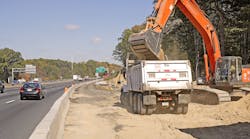In an extensive newly released report, the National Association of Counties (NACo) argues that both federal and state funding and financing of county-owned transportation infrastructure is “increasingly inadequate” within the 48 states that have a county-government system (Connecticut and Rhode Island are the exceptions).
Per NACo, “The Road Ahead: County Transportation Funding & Financing” analyzes “funding sources, challenges and solutions” for the roads and bridges owned and maintained by the nation’s counties.
The 40-pg. report includes three case studies to provide an in-depth view of “the issues facing counties in funding safe and reliable transportation systems.”
Counties, noted NACo, invest $106.3 billion in public facilities and infrastructure each year and are responsible for building and maintaining 45% of the public roads and 230,690 bridges as well as being involved in 30% of the nation’s transit and airport systems.
“The U.S. transportation system is the ‘circulatory’ system of the U.S. economy that requires a cohesive resolution for a strengthening economic recovery on the ground,” said Dr. Emilia Istrate, NACo’s director of research and lead author of the report.
“The ideal is a transportation system that helps the U.S compete globally, saving businesses and citizens time and money by reducing traffic congestion and helping American communities grow economically and restore their quality of life,” added Istrate.
According to NACo, the impending expiration of the current federal surface-transportation funding law, MAP 21, “presents an opportunity for counties to discuss their role in the national transportation network.”
To that end, the report argues three key points:
- Federal and state funding for county transportation projects is “increasingly inadequate”
- Counties “face the dilemma of rising costs of transportation projects, increasing traffic volumes and limitations on their ability to generate revenue”
- Counties have adopted additional funding and financing mechanisms—“but they are not sufficient to cover the needs of their economies and residents”
Regarding inadequate funding, the authors point out that, based on Federal Highway Administration (FHA) data, the share of federal and state funding to local governments for highways decreased by 10% between 1998 and 2011. “The latest federal surface transportation law (MAP-21) further skewed the allocation of funds away from local governments,” they state. “While local governments own 43% of the federal-aid highways system, local areas receive a sub-allocation that is equal to 16% of the MAP-21 National Highway Performance Program (NHPP) and the Surface Transportation Program (STP) funding for federal-aid highways. A combination of federal budget cuts, the effect of the recession on state governments and the fixed gas tax nature of state and federal highway funding are contributing to a widening gap in transportation funding available to counties.”
As for the three-fold cost/traffic/revenue “dilemma” that counties face, the authors maintain that the cost of construction and materials increased by 44% between 2000 and 2013-- more than the 35% rise in the overall rate of inflation. “Fast-changing economic environments put pressure on county transportation systems, especially in states with rapidly expanding oil and gas industries,” the report points out. “At the same time, most states limit counties' ability to raise revenue. Forty-three states have some type of limitation on the property taxes collected by counties, including 38 states that impose statutory limitations on property tax rate, property tax assessments, or both. Only 12 states authorize counties to collect their own local gas taxes, which are limited to a maximum rate in most cases and often involve additional approvals for implementation.”
And when it comes to attempts by counties to adopt additional funding and financing mechanisms, the report states that “Counties increasingly use local-option sales taxes to fund transportation projects, if allowed under state law. Twenty-nine states allow counties to collect local-option sales tax for transportation purposes or general purposes including transportation.”
The report notes that other funding and financing methods employed by counties have included county residents in 15 states voting for local-option sales taxes for road and capital projects as well as partnerships with state and local governments that have allowed counties in Pennsylvania and Ohio to pool resources and materials to save money on transportation projects.
In addition, counties in states such as Iowa, Missouri and Nevada have implemented ”land-value capture options such as tax increment financing, special assessment districts and development impact fees, linking transportation investments to the economic growth in their counties.” And for large and complicated capital projects, counties have partnered with the private sector in Public-Private Partnerships (PPPs), such as Miami-Dade County's Port of Miami tunnel project.
However, the authors contend that these local solutions are “not a sufficient solution to the problems facing a big portion of the nation’s overall transportation network. Counties need the federal government to continue to work with them and the states in funding and financing the U.S. surface transportation system.”
Absent such partnering, they argue, the result will be “a piecemeal approach to an integrated network of roads, bridges and other transportation modes.”
What’s more, state the authors, “A seamless network of roads and bridges needs consistency in construction and maintenance across the entire U.S. transportation system. All levels of government participating in this responsibility must also share funding and grant counties the ability to generate additional revenues. This requires all owners of roads and bridges to work together to maintain and improve the U.S. surface transportation network.”
Accompanying the report is an interactive “data tool” that profiles 43 states in which counties have authority over roads and/or bridges. Information on these includes county roads and bridges; fuel-tax type and rates; local fuel tax; local-option sales tax; and state limits on property tax.
Founded in 1935, NACO is the only national organization that represents county governments in the U.S.



